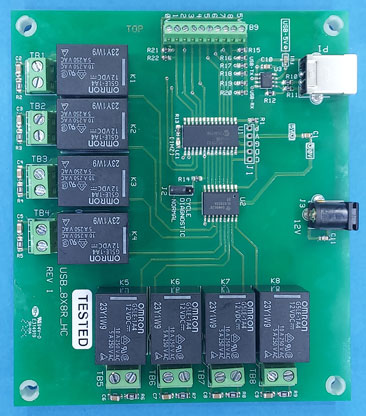


USB-8I-8R-HC (High Current)
Features:
The Controller (BrightSign or other controller) has to send a single byte to control the 8 relays. The bits of the 8 bit byte controls the 8 relays.
At any time, the Brightsign sends out the 'Set Port Byte', then the relays will turn on according to the bit pattern of the 'Port Byte'. I.E. Bit 0 of the byte set to '1', will turn on Relay1. Bit 7 of the byte set to '1' will turn on Relay 8.
I.E. To control the relays, send the byte that represents the bits of the relays (see table below). The single byte turns on/off the relays according to the bits!
Just add the decimal numbers together to get the bits set that you want. Setting all bits on is 255d (decimal). Setting bits 0 and 7 on is 128+1 or 129 decimal
The Relays have a terminal Block for connections (no bus)
DC Voltage 'Large Inductive loads' may require a diode to be placed across the load. Without the diode, the inductive 'kick' when the relay is turned off can reset the microprocessor! AC loads require a snubber network across the contacts of the relay on the HMS board. The board has built in snubber networks AC/DC loads. The snubber networks may be insufficient for preventing reset when driving highly 'inductive' DC loads such as a 'contactor relays' or a motor.
As inputs are closed, a string representing inputs 1 to 8 is sent (2 bytes). I.E. "1",13 (ascii 1 followed by a carriage return for input 1 closure. This way the BrightSign will respond to the inputs after a carriage return.
When all inputs are released, a 'zero string' is sent. I.E. "0",13 (ascii 0 followed by a carriage return
| Note: External Supply Voltage: An External 12 Volt, 1amp Power Supply is needed to power the relays. |
Author: Richard Harkey
Revised: August 17, 2024